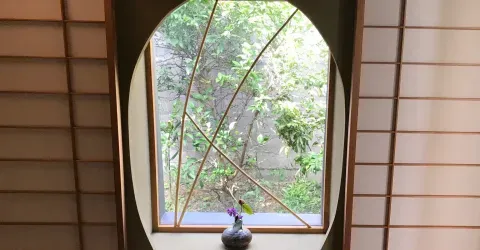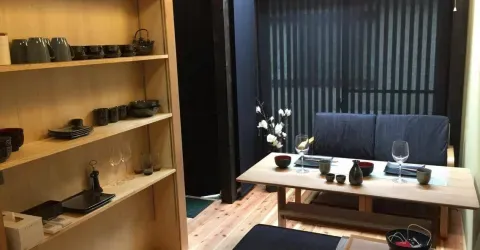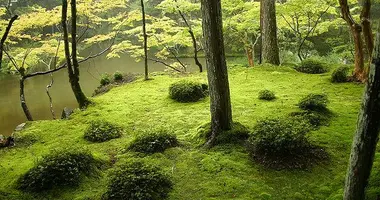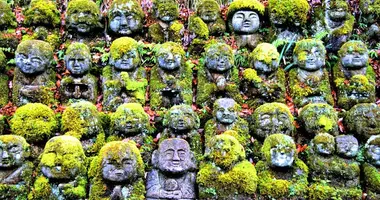Gioji Temple: a hidden gem with a tragic love story in Kyoto's Arashiyama district

Nestled in the serene Arashiyama district of Kyoto lies a hidden gem known as Gioji Temple. This small but enchanting temple offers visitors a unique blend of history, natural beauty, and spiritual tranquility. With its lush moss garden, thatched-roof main hall, and intriguing backstory, Gioji Temple provides a captivating experience for those seeking to explore beyond Kyoto's more famous attractions. As you step into this peaceful sanctuary, you'll be transported back in time and immersed in a world where nature, art, and human drama intertwine. Let's delve into the fascinating story and breathtaking sights that await at Gioji Temple.
The history and legend of Gioji Temple
The origins of Gioji Temple date back to the late 12th century, during the tumultuous Heian period. The temple's name and legend are inextricably linked to the tale of Gio, a beautiful dancer who became entangled in a tragic love story. According to the famous epic "History" known as the Tale of the Heike, Gio was a talented shirabyoshi dancer who caught the eye of Taira no Kiyomori, a powerful military leader.
The story goes that Kiyomori was captivated by Gio's beauty and skill, making her his favored consort. However, their relationship took a dark turn when Kiyomori's affections shifted to a younger dancer named Hotoke Gozen. Heartbroken and humiliated, Gio made the decision to retire from her life as a dancer and become a Buddhist nun. She retreated to this very temple, accompanied by her mother and younger sister, Ginyo.
In a twist of fate, Hotoke Gozen eventually joined Gio at the temple, seeking forgiveness and a life of spiritual contemplation. This poignant tale of love, betrayal, and redemption has been immortalized in Japanese history and literature, adding a layer of emotional depth to the serene atmosphere of Gioji Temple.
Architecture and features of Gioji Temple
Despite its small size, Gioji Temple boasts several architectural features that make it a unique and charming destination. The centerpiece of the temple is its main hall, or hondo, a modest thatched-roof building that seamlessly blends with the surrounding nature. This simple yet elegant structure was donated to the temple in 1895 by Kitagaki Kunimichi, a former governor of Kyoto Prefecture.
Inside the main hall, visitors will find wooden statues depicting Gio, her sister, and the other women associated with the temple's legend. The principal deity enshrined here is Dainichi Nyorai, the Buddha of Cosmic Light and Wisdom. One of the most distinctive features of the hall is a beautiful circular window with crisscrossing panes, which allows soft, filtered light to illuminate the interior.
Gioji Temple belongs to the Shingon sect of Buddhism, and its architecture reflects the simplicity and harmony with nature that are hallmarks of Japanese Buddhist design. The temple's intimate scale and integration with its natural surroundings create an atmosphere of tranquility and contemplation.
The stunning moss garden and seasonal beauty
The true star of Gioji Temple is undoubtedly its breathtaking moss garden. Covering the temple grounds in a lush green carpet, the garden is home to over 120 different species of moss. This diversity creates a rich tapestry of textures and shades, ranging from pale lime to deep emerald. The moss garden is carefully tended by skilled gardeners who maintain the delicate balance of shade and moisture required for the moss to thrive.
The beauty of Gioji Temple's moss garden changes dramatically with the seasons, offering visitors a unique experience throughout the year. In spring, the garden comes alive with the soft pink hues of cherry blossoms, creating a stunning contrast against the vibrant green moss. Summer sees the moss at its lushest, providing a cool respite from the heat. Autumn transforms the garden into a breathtaking display of fiery colors as the surrounding maple trees don their autumn leaves, creating a striking contrast with the evergreen moss.
Even in winter, the garden retains its charm, with the moss taking on a deeper hue and occasionally dusted with snow. The changing seasons offer photographers and nature enthusiasts endless opportunities to capture the garden's evolving beauty.
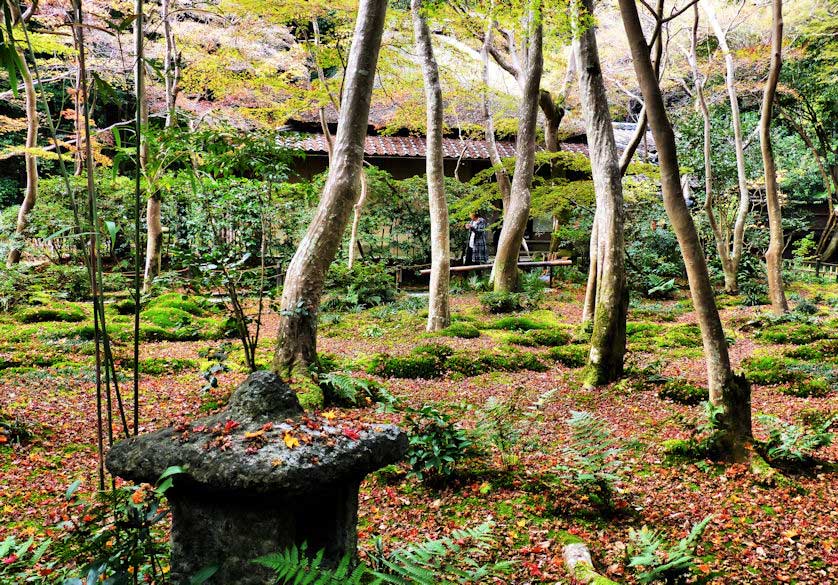
Gioji Temple, Sagano, Arashiyama, Kyoto
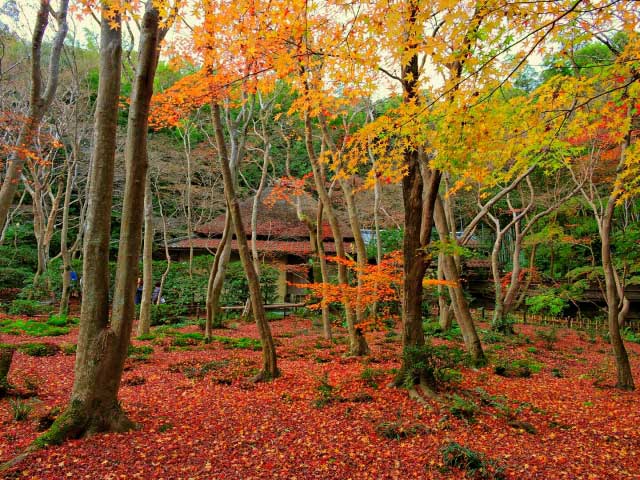
Gioji Temple, Sagano, Arashiyama, Kyoto
Exploring the temple grounds and main hall
As you enter Gioji Temple, you'll be immediately struck by the serene atmosphere that permeates the grounds. The path leading to the main hall winds through the moss garden, allowing visitors to immerse themselves in the lush greenery. Along the way, you'll encounter stone lanterns and a small stream that adds to the peaceful ambiance.
Inside the main hall, take a moment to appreciate the wooden statues that bring the temple's legend to life. The statues of Gio, her sister Ginyo, their mother, and Hotoke Gozen serve as a poignant reminder of the human stories that have shaped this place. The statue of Dainichi Nyorai, the principal deity, invites quiet contemplation.
As you explore the grounds, you'll notice how the temple seamlessly integrates with its natural surroundings. The towering maple trees provide shade for the moss garden, while bamboo groves rustle gently in the breeze. This harmonious blend of architecture and nature creates a deeply calming and meditative environment.
Practical information for visiting Gioji Temple
Gioji Temple is open to visitors daily from 9:00 AM to 5:00 PM, with last admission at 4:30 PM. The admission fee is 300 yen for adults and 100 yen for elementary school students. It's worth noting that for 600 yen, you can purchase a combination ticket that also includes entry to nearby Daikakuji Temple.
To fully appreciate the tranquil atmosphere of Gioji Temple, it's recommended to visit during the quieter hours of the morning or late afternoon. This will allow you to experience the garden's serenity without the crowds. If possible, try to time your visit after a light rain, when the moss appears at its most vibrant and lush.
Photography is generally allowed in the temple grounds, but be mindful of any specific restrictions, especially inside the main hall. Remember to treat the moss garden with respect by staying on the designated paths and refraining from touching or walking on the moss.
Nearby attractions and things to do in Arashiyama
Gioji Temple is located in the picturesque Arashiyama district, which offers a wealth of attractions and activities for visitors. After exploring Gioji, you might want to visit some of these nearby sites:
- Tenryuji Temple: A UNESCO World Heritage site with stunning gardens and architecture.
- Arashiyama Bamboo Grove: A magical forest of towering bamboo, perfect for a serene walk.
- Adashino Nenbutsu-ji: A unique temple with thousands of stone statues.
- Jojakko-ji Temple: Known for its beautiful autumn colors and city views.
- Togetsukyo Bridge: An iconic landmark spanning the Katsura River.
For a more immersive experience, consider renting a bicycle to explore the area or taking a ride on the scenic Sagano Romantic Train. The charming streets of Arashiyama are also perfect for a leisurely stroll, offering opportunities to sample local cuisine and shop for traditional crafts.
How to get to Gioji Temple
Gioji Temple is easily accessible from central Kyoto using various transportation options:
- From Kyoto Station: Take the JR Sagano Line to Saga-Arashiyama Station. From there, it's about a 20-minute walk to Gioji Temple.
- From Shijo Kawaramachi Station: Take Kyoto city bus #11 for about 50 minutes and get off at Saga Elementary School. From there, it's a 17-minute walk to the temple.
- By Keifuku Line: Get off at Arashiyama Station and walk for about 20 minutes.
For those who prefer a more scenic route, consider taking a taxi or renting a bicycle to explore the Arashiyama area at your own pace. The journey to Gioji Temple is part of the experience, allowing you to soak in the beauty of Arashiyama's picturesque streets and natural surroundings.
Gioji Temple may be small in size, but it offers a profound and memorable experience for those seeking a deeper connection with Japan Temples & Shrines. Its tragic love story, stunning moss garden, and serene atmosphere make it a must-visit destination for anyone exploring Kyoto's Arashiyama Temples. As you stand in the midst of the lush green moss, surrounded by the whispers of ancient trees, you'll understand why this hidden gem continues to captivate visitors from around the world.
